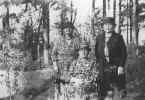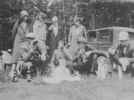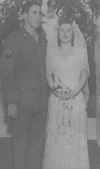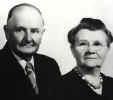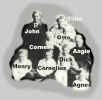|
by Henry Slotemaker Part Six---1918-1964
She also suffered from gall stones for several years. I do not remember when it started but my best guess is about 1920. At that time surgery was apparently not recommended except as an absolute emergency. When a stone was passing the pain was excruciating. The attacks usually came at night, and her screaming and moaning kept the family awake. In the morning she was completely exhausted and looked the part. From an acquaintance we learned of a remedy developed by a pharmacist in Grand Rapids, Mich. She started using this medication and continued using it as prescribed until the attacks stopped. Apparently the existing stones passed, and no new ones formed. Anyway, she was relieved of this malady and we were all thankful for it. This medication continued perhaps 2 years. Except for Motherís chronic leg ulcer, and Dadís hernia which caused discomfort at times they enjoyed good health during the remainder of their lives, until their final illnesses. During the latter part of World War I and for some time thereafter there was an acute shortage in the labor force in the country. This was evident on the farm too. Consequently many teen age boys were doing menís work. Much was hand work. Neal and I contributed our share in supplying the need in our neighborhood. Horses provided the power for field work. Except for occasional off the farm jobs in the neighborhood the family had all remained pretty much at home. Much of the farm was wooded. The trees were marketable only as firewood; and this market was mostly supplied by the lumber mills, and the few who made wood cutting their business. Our farm was unique in that it had 22 old growth fir trees that had somehow survived the forest fires that devastated many thousands of acres in the area leaving fallen trees and black stumps. These 22 survivors ranged in size from about 3 Ĺ feet to 6 Ĺ feet in diameter at about 5 feet above the ground; and from about 150 to 220 feet in height. Most of the burned over area was covered with a new growth including a few clumps of fir, an occasional cedar, and generally alder and birch, and various other species of trees and brush. When we arrived on this place in 1912 there was about 30 acres of clear farm land; about 20 acres partially clear and suitable for pasture. The other 50 acres was all wooded and could serve as pasture for young stock. So there was always work to be done. Perhaps I should explain why those old growth trees were not suitable for lumber. They stood singly (not in a forest). This made them vulnerable to all the winds. In a strong wind the tree top could sway perhaps 20-25 feet or more from side to side, breaking the wood fibers in the center of the tree killing it. The tree would die from the top down and rot from the center out. Looking at a tree one could not know how much good wood it contained. Most of the fences on the farm were built with split cedar rails. As these fences deteriorated they were replaced with barbed wire fences; the best rails being used for posts, the rest was cut up for firewood. This indicates the abundance of material at hand to keep the home fires burning.
Post World War I years were a time of fast
emergence from the "horse and buggy" days to the
"machine age". Many automobiles were kept in storage during
the winter due to road conditions. This necessitated a general road
improvement program. When the funds appropriated by the Township ran
out, the work was continued with voluntary labor. We contributed our
share to both paid and volunteer labor. This meant shoveling gravel It soon became evident that Nealís ambitions
for a livelihood were not directed toward farming.1 His first off the
farm employment Ė except for occasional jobs as mentioned in the
foregoing Ė was for a wholesale and Our first automobile was a used Chevrolet
purchased in 1920. As Neal and I were the main beneficiaries, (Dad
never learned to how drive) we felt responsible for a large part of
the operating cost. The horse and buggy were
It must be taken into account that this was when radio was still in its early stages of development, and T.V. was perhaps still in science fiction state; or a dream in some inventors mind. 2Social activity by young people stimulates friendships, many of which continue through life. This general response was also evident in our family circle. The automobile served to broaden this social circle as distances became a steadily decreasing barrier.
One morning in the summer of 1927, when we got up to do our regular chores Ottoís bed was empty. He hadnít come home that night. He left a note stating in effect that he thought it best for all concerned that he leave home and find employment elsewhere. He left with a companion, and urged us not to notify authorities to have him returned home. He promised to keep us informed as to his whereabouts. Needless to say, this was a shock to all of us, especially our parents. This new experience called for introspection and prayer for wisdom to do what was best. In trying to determine why he left home the way he did we came up with the following: He being the youngest of the brothers was not given his share of responsibility. This could leave him with a demeaning, frustrating feeling, to which he responded by asserting himself the way he did proving that he could take care of himself. But whatever his motives, his action left a deep impression on the family. A few days after he left we received a letter from him informing us that he had a job in the Yakima valley picking peaches. From there he went to Burns, Ore. where he worked on a ranch.3 When winter came he went to a place near the Oregon coast where he found a job. I do not remember how long he was away from home, which I think was less than a year. It was a happy occasion for all of us when he returned. Otto was a quiet person. Although he could carry on an interesting conversation, he was not talkative. If one would comment on his silence he would likely reply: "I learn more when I listen than when I talk". I think Dad had a fond ambition to place each of
his sons on a farm. That this was not to be realized soon became
evident. Neil quite early in life indicated that his interests lay in
other directions. Being second in age, I assumed an increasing amount
of responsibility, both as to the work and management of the farm.
This in turn led to Dick and Otto to go elsewhere for employment. The
depression of the early 1930ís extinguished the last spark of that
ambition. We Gradually emerging from the depression, social life also returned to a more normal course. Dick met his life partner in the person of Ann Sebens, a neighbor girl whom he married on June 12, 1934. Later that same year Otto entered the marriage state with Nellie Cook on Sept. 4 in Wenatchee, Washington. The family was growing again. About at this time Motherís brother Martin died in Iowa, leaving a sick widow and two children: Alleta and Henry. Mother and Dad were asked to serve as guardians of these children, which they consented to do. They stayed about 3-4 years when they were through grade school, and their mother had recovered sufficiently to make a home for them again.
We continued to operate the farm together, Dad helping to the extent of his ability. We built a new small house on the farm, Mother and Dad continuing to live in the old farm home.
Jessie, now 22 was clerking in a store in
Bellingham. While helping at a U.S.O. "United Service
Organization", a place where service men were fed and
entertained, she met a young soldier from Illinois named Mervin
Figenbaum. This acquaintance led to a mutual interest in one another.
He was sent to France. He was wounded in combat.4 After sufficient
recuperation to travel he came back to see Jessie. Their interest grew
into Mother and Dad continued a deep interest in and
concern for their posterity. There is no way of estimating the time
they spent in prayer on our behalf. Dad had a habit of thinking
audibly. Many a time I came upon him unaware and heard him talking,
and almost invariably it concerned religious-spiritual
matters. Both
continued to have a deep interest in the work of the church. Mother
remained Mother continued to live on the farm for some time. Joe Estie had converted his garage to an apartment where their daughter and son-in-law, Jean and Warren Yonker, lived until they needed more room. This proved to be an ideal arrangement for mother. She lived in this apartment for some 12 years. She was within walking distance of the church, rest home, and the homes of many of her personal friends, as well as a convenient place for us to stop in. Except for her leg ulcer which limited her activity she continued in excellent health. Much of her time was occupied by needle work, especially knitting. She must have knitted thousands of garments of various descriptions in her lifetime, as she learned to knit at the early age of 8 years while still in the Netherlands. She was also an avid reader, but she was able to knit and read at the same time, so there was no conflict of interest between the two activities. She also kept up a correspondence with family members and other relatives in distant places, thereby keeping contact by which all of us benefited.
Footnotes 1. Perhaps the following information, related by Neil's sister Agnes, helps explain part of Neil's aversion to farming---According to Agnes, Neil was hit by lightning; it was in the Fall, the men and boys were out in the field, shocking the hay when a storm came up. They continued to work, hoping to get as much hay shocked as they could. Neil was using a pitch-fork to throw the hay, and the pitch-fork was hit by lightning. He was thrown backwards and landed on the ground. They all came in for the day. compiler's note: 2. Anyone growing up in Lynden would hear the phrase 'Dutch Parade' which referenced the phenomenon of a large number of cars going up and down Front Street. Most Generation 5 age group Lyndenites and Dutch descendants likely think that this is all the 'Dutch Parade' phrase refers to, a local colloquialism. However, according to Generation 4 Dutch Lyndenites there is more to it than that. There was no evening Church service on Sunday evenings, however on Sunday there would be a meeting of the 'Young Peoples Society' and after the meetings of these young people, girls would walk on the Front Street side walks and young men would drive by in their cars offering rides to the young ladies in the 'Dutch Parade'. According to Generation 4 Slotemaker descendant Howard Spaan, who as a teenager grew up in Lynden, the 'Dutch Parade' practice was common in other Dutch towns in America as he remembers as a teenager visiting a family in a Dutch town in Iowa where his uncle was a constable, and that Iowan Dutch town had the same 'Dutch Parade' tradition as Lynden, although with a slight twist; you couldn't go around town more than three times or you would be ticketed. 3. Otto Slotemaker wrote of his Oregon ranching experience in a typewritten document which he waited 40 years to create, finally committing his story to paper in 1969. This document has recently resurfaced and has now been transcribed to this venue. Anyone with additional details about Otto's tale, please share. 4. Mervin Figenbaum was transferred overseas to Europe to take an active part in the fighting in Europe. He landed at Normandy (Utah Beach). He joined the 3rd U.S. Army, commanded by General George S. Patton. Mervin was a Combat Engineer Specialist. Normandy was his first campaign. Next he was on the Rhineland Campaign; then the Ardennes Campaign, better known as the "Battle of the Bulge"; then not the least was the Central Europe Campaign. After being wounded, the doctors at the Evacuation Hospital in Germany told him that he had million dollar wounds and they were sending him home. He arrived back in the United States during the summer of 1945. 5. Visit the final resting place of many of those you've read about in the Slotemaker Story Continue to the Final Words
|
